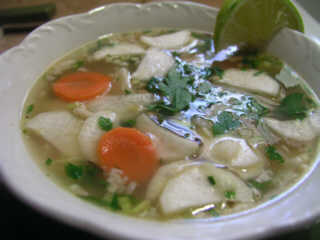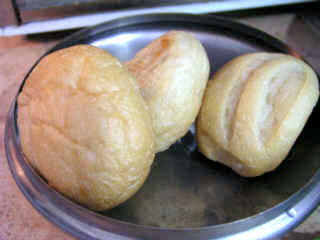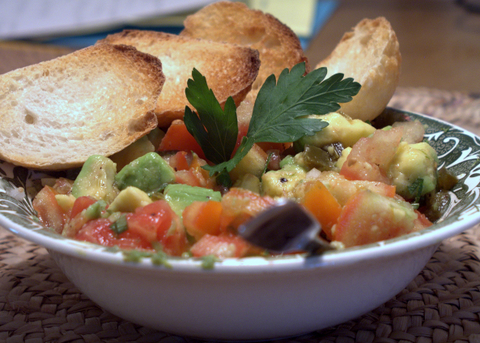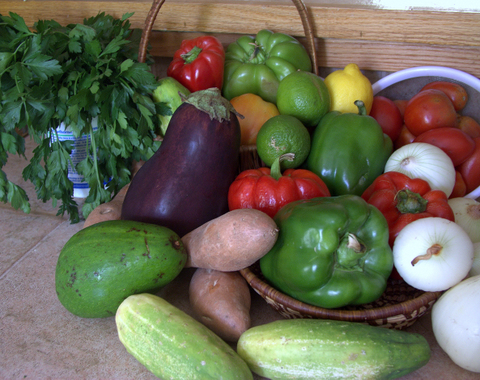Living on $42.00 per Week-Day 4
July 19th, 2007Total food stamp funds remaining: $17.87.
Lunch Wednesday:

After yielding two meals, our weekend chicken didn’t owe us a thing. Nonetheless, we took the remaining bones (approx.. 6 oz. including the bits of meat clinging to them) and made our version of “stone soup *.”
Placing the bones in a 3-quart sauce pan with approx. 3 cups of water, we simmered them for 15 minutes then strained the liquid, reserving the bones. When the bones were cool enough to handle, we stripped them of their meat. Suprisingly, we had nearly 3/4 of a cup.
We brought the chicken broth back to a boil and added 1/4 cup of medium-grain white rice, some minced ginger root, garlic, and 2 kaffir lime leaves **. Having reduced the heat, we let the covered pot simmer for 15 min., until the rice was done.
Sunday’s pre-cooked carrots were thinly sliced and put into the pot along with a rib of celery and a scallion (both minced). In the spirit of “Archeology begins at home. Excavate your own fridge first,” we also tossed in half-moon slices from a piece of daikon found lurking on the bottom of the vegetable bin.
A dash of hot sauce, salt & freshly ground pepper, and a few snips of flat-leaf Italian parsley (because we’d forgotten to buy cilantro) finished this lively, vaguely Thai-tasting soup. It gave us 2 servings each.
Stone Soup provides a great illustration of how we—and anyone else—can make a tight food budget work. Leftovers aside, imagination and a little effort are the crucial ingredients in any satisfying dish.

This meal marked the last of our day-old rolls from BJ’s. They’ve served us well. And with our little trick with the kitchen faucet and the toaster oven, they’ve provided a satisfying accompaniment to many of the casual meals we’ve been enjoying this week. And at $2.00 for eighteen rolls, they rank along side our produce supply as one of the best bargains we’ve found for this experiment.
* Stone Soup: The old parable of how those with little, gain much if they share what they do have.
** This may seem a bit over-the-top on a food-stamp budget, but we’ll explain: we’d bought the kaffir lime leaves from our local Vietnamese grocer before Christmas last year. For $1.00 we came home with a bag containing approximately 70 of these beauties. They keep well in the freezer, and we’ve simply been dipping into the bag as recipes warrant. Though we also have lemon grass growing in our back yard, we decided against using it for this recipe in the interest of time and simplicity.
Supper Wednesday:
Midway through our challenge, the Sicilian half of this duo was suffering from pasta withdrawl. What better way to assuage the malady than to use up 3/4 cup of ricotta left from last week? Because we also had some Red Barn eggplant, and because it was already after 8 PM, and because we often turn to other sources for inspiration, we Googled “ricotta + eggplant + pasta” and found ourselves on the Food & Wine website. A recipe for pasta with eggplant, ricotta, and tomatoes was right there. Did we follow it? Not really, but sometimes all one needs is an idea.
Eggplants have earned a bad reputation for being oil sponges. Cooks of all stripes have long tried to devise techniques to keep their eggplants from absorbing all that precious olive oil. Among alternatives to frying is merely brushing eggplant slices with oil and either baking them or putting them under the oven broiler.
We have two oil-free techniques, each of which flies in the face of centuries of Italian cookery. One, is to use our George Foreman outdoor grill. It gets just hot enough to cook the eggplant slices through without burning them. We can season them later when we assemble a dish like eggplant parmigiana or mousakka
The other prep method is more radical, more counter-Italian than even an electric grill: we steam our eggplant. This requires total attention, because eggplant can quickly go from firm to mushy. But steaming uses no oil and takes approximately 3 minutes.
If steaming eggplant is radical, our method for cooking pasta will send Italians, Italophiles, and foodies in general into paroxysms. Depending on the recipe, whenever we can, we use our trusty Pasta Perfect, *** as seen on TV. (That’s according to the blurbs on the box. We don’t have cable; for that matter, we don’t even own a TV.)
Before moving to Sarasota, we bought our Pasta Perfect as a joke at one of those “job lot” stores in Connecticut. However, it turned out the joke was on us. It works…mostly. We can cook spaghetti or linguine to the al dente state. But certain shaped pastas—like penne, rigatoni, or shells—will cook only so far and no further, no matter how long they sit in steaming water. That’s okay because the only time we use Pasta Perfect is when we plan to finish cooking our pasta in a sauce.
But the benefits of our Pasta Perfect outweigh the laughs. We need boil only two quarts of water rather than six; once the water comes to a boil, we can turn off the stove, saving energy. We don’t need a colander because the top of our Pasta Perfect is perforated for easy drainage. Finally, when we’re done, clean-up is not a pot and a colander, but just the single plastic tube of Pasta Perfect.
Alas, delicious as this recipe may be, it turned out to be brutta ma buona, that is, not particularly photogenic.
Pasta with Eggplant & Ricotta
Ingredients:
1 Small eggplant, approximately 1/2 Lb., cut into 3/4 in. cubes
Olive Oil
2 Cloves garlic, sliced
1 Small onion, diced
1 tsp. Crushed red pepper flakes
4 – 5 Plum tomatoes, coarsely chopped
3/4 Cup whole milk ricotta
1/4 Cup flat-leaf Italian parsley, finely chopped
Salt & freshly ground black pepper
Parmigiano cheese
1/2 Lb. Short, tubular pasta (We used campanelle. Substitute penne, rigatoni, or mostaccioli if you prefer)
Preparation:
Bring about 1 in. of water to a boil in a three-quart saucepan. Add 1 Tbs. salt, then the eggplant. Reduce heat to medium-low and steam the eggplant for approximately three minutes, or until it’s slightly translucent and tender. Drain in a colander and reserve.
Heat a large saute pan over medium-high heat. Add just enough olive oil to film the bottom of the pan, then add the garlic, onion and red pepper flakes. Lower the heat slightly, and saute the mixture until the onion is wilted; three or four minutes.
Add the tomatoes, and cook until they soften and begin to render some of their juices. Add the eggplant, and cook to heat through. Taste for seasoning and add salt & pepper as necessary.
Reduce heat to low, and stir in the ricotta. Maintain on low heat while the pasta cooks.
Cook the pasta in your traditional way, according to the manufacturer’s recommendations. When the pasta is al dente, drain and add it with the parsley to the sauce. Raise the heat slightly and cook, stirring gently to keep it from sticking, for two or three minutes until the pasta is done, and has absorbed some of the sauce.
Pour the pasta into a large bowl, garnish with freshly grated Parmigiano, and serve family-style.
Ordinarily, this would be sufficient for four as a pasta course. Since it was our whole dinner, this served two abundantly.
*** We agree, Pasta Perfect is so strange, it deserves a blog post of its own. We’ll put that on our to-do list for the future when we’ve finished writing about our Food Stamp Challenge experiences.
Links to the other posts in our series:
Living on $42.00 Per Week—the Challenge
Living on $42.00 Per Week—Day 1
Living on $42.00 Per Week—Day 2
Living on $42.00 Per Week—Day 3
Living on $42.00 Per Week—Day 5
Living on $42.00 Per Week—Day 6
Living on $42.00 Per Week—Day 7
Living on $42.00 Per Week—Summary
Living on $42.00 Per Week—Redux
Living on $42.00 per Week-Day 3
July 18th, 2007Total food stamp funds remaining: $17.87.
Lunch Tuesday:
Last night’s supper became the basis for lunch today: we supplemented the leftover chunks of potato salad, tomato slices , and about half a cup of ceviche with an additional boiled potato, five leaves of torn Romaine, and one more tomato to yield a lunch-sized salad for two. The marinades, juices, and herbs from the three dishes were almost adequate as a dressing, but we added a little more vinegar and another spoonful of olive oil. Along with the salad, we had some of our day-old BJ’s rolls.
At this point, our rolls are becoming a little long in the tooth, but we know a trick to revive them: we simply pass them quickly under running water, shake them off and toss them into the toaster-oven at approximately 375 F. for five to ten minutes. Voila!! nearly fresh rolls.
As we go along with this experiment, we’re seeing a theme emerge: maintaining a reasonable diet on such a limited budget requires significant thought and planning. And we admit it—we have another advantage: we truly enjoy the process. For example, on Sunday, while cooking potatoes for our dinner salad, we added a few extras, just to have them available as ready-to-use components of other dishes later in the week. So it was easy today to augment leftovers from last night with another potato.
We also had carrots in the fridge before we started. We par-cooked two of them for three minutes with the potatoes even though we had no specific use in mind. Now, they’re available when we make a quick soup or perhaps for a carrot salad.
Our endeavors have not been limited to shopping and cooking. We’ve also been at our desks—reviewing other blogs and news sources concerning the “Food Stamp Challenge.” As part of an organized program (May 15-21, 2007), several members of Congress and numerous bloggers across the country attempted to survive on the weekly allotment of $21.00*.
We have observed something noteworthy: many of the participants didn’t cook. They simply went to the grocery store and bought the cheapest food they could find. It’s laudable that many of them bought apples, bananas, salad ingredients, and canned tuna fish, but there seemed to be no underlying strategies, and they found that they quickly depleted their weekly allowance. We said at the outset we had an edge as foodies who know how to cook. And unless you live in an area with markets that sell low-cost vegetables, following our program would be an even bigger challenge. We feel that to make the experiment work, and for that matter to make food stamps work in the real world, one must cook, or be part of a household or social group where someone else cooks—from scratch.
Of course $21.00 per week for food is Spartan by any American’s definition. But we’re not so married to our liberal ideals that we think increasing the weekly allowance is the whole answer (although it’s a good start). In order to succeed, no matter how large the budget, we feel that part of the food stamp program should involve some kind of education. At a minimum, the program needs an instructional component that shows food stamp recipients how to select, prepare, and store fresh food. Bilingual pamphlets won’t do it—we mean instruction: free classes, demos in schools, DVDs, TV—anything to show people how to make appealing and healthy food on a shoestring. Oprah and Cristina, are you listening?
We feel, for example, that those bags of pre-washed, pre-cut lettuces are among the worst ways to use our food budget (sorry, Rachael Ray.) At mainstream grocery stores here in Sarasota, a bag of pre-washed lettuce would deplete an individual’s weekly food stamp budget by nearly 20%. On the other hand, a head of Romaine—even if it is slightly wilted—costs $1.00 at the open produce market. We revive it by simply cutting a small piece from the base and standing the head upright in an inch or so of water, (in a recycled yogurt container). We place the lettuce on the shelf of the fridge door, like a bouquet (We use the same trick to keep our parsley from wilting.)
We think it is legitimate to ask: do most people with food insecurities own salad-spinners or know how to wash greens and then, know how to store them? And we’ve not even arrived at the point of food preparation! A lot of people don’t know how to dress a salad with oil and vinegar, how to sweat collards, or how to stir-fry sliced zucchini.
Supper Tuesday:
Once again, we brought out our Wal*Mart rotisserie chicken, divided the remains in two, so we each had a serving of breast meat and a wing (a less elegant version of the “Statler breast”). We simmered two of our sweet potatoes till tender, slipped off their skins, and mashed them with garlic, a little salt, and coarsely chopped parsley. An apple found in the fridge became a fresh chutney with green bell pepper, ginger root, lime rind, lime juice, and a dash of chili sauce.
* The weekly food stamp allowance varies from state to state—on the Web we’ve found allotments ranging from $19 to over $24 per week. $21 is our Florida figure.
Links to the rest of the posts in our series:
Living on $42.00 Per Week—the Challenge
Living on $42.00 Per Week—Day 1
Living on $42.00 Per Week—Day 2
Living on $42.00 Per Week—Day 4
Living on $42.00 Per Week—Day 5
Living on $42.00 Per Week—Day 6
Living on $42.00 Per Week—Day 7
Living on $42.00 Per Week—Summary
Living on $42.00 Per Week—Redux
Living on $42.00 per Week-Day 2
July 17th, 2007Here is a brief follow-up to our first day’s culinary adventures.
On Sunday afternoon, we went to Whole Foods, where we bought approximately 3 Lbs. of a halibut frame. For those who may not know that term, it’s merely the carcass, left over after the fish has been filleted. Whole Foods will be happy to sell you all or part of a fish frame (also known as a rack) for $1.99 per pound.
Sometimes, a seemingly inedible foodstuff can serve as the catalyst for several meals. In the case of our fish frame, we’ll make at least three and possibly four quarts of fish broth. From there, we can make a Mediterranean fish soup, seafood risotto, or perhaps a seafood couscous. With options like these, $1.99 per pound struck us as a bargain. And when we saw how much meat was left on this fish frame, we had no problem parting with $6.11.
Total food stamp funds remaining: $17.87.
Sunday Supper:
We simply removed our Wal*Mart rotisserie chicken from the fridge and allowed it to come to room temperature. For this meal, we served the leg and thigh quarters along with boiled potatoes and sliced plum tomatoes dressed with olive oil, red wine vinegar, and chopped flat-leaf Italian parsley.
We cut the boiled potatoes into bite-sized pieces and tossed them—skin on—with two minced scallions, a couple of Tbs. each of flat-leaf Italian parsley and spearmint ( we keep ours growing a pot on our porch). A scant Tbs. of olive oil and approximately two Tbs. of citrus vinegar, salt, black pepper and a dash of chili sauce finished the potatoes.
On Tuesday, we’ll very likely finish the chicken, although we’ll still have the remainder of the carcass. Cooked chicken bones may not make a great stock, but they still have a lot of flavor to contribute. We haven’t thought that far ahead, but we’ll surely figure out something to do with them.
###
Monday Lunch:
We put together a salad of avocado and tomatoes that, although the essence of simplicity, was entirely satisfying. Along with some rolls from the day-old shelf at BJ’s —sliced and toasted as crostini—we had a delicious lunch.
Avocado & Tomato Salad

Ingredients:
1/2 Large Florida Avocado, cut into small cubes
1 Med. tomato, coarsely chopped
1 Pickled jalapeno, minced
1/2 tsp. grated lime rind
1/2 tsp. grated fresh ginger
6 fresh mint leaves, finely chopped
3 or 4 grinds from the pepper mill
1/4 – 1/2 tsp. salt
2 – 3 tsp. lime juice (the juice from approximately 1/2 lime)
1 Tbs. onion, finely chopped
Preparation:
Combine the avocado, tomato, jalapeno, lime rind, ginger, and mint leaves in a non-reactive bowl. Stir gently to mix. Add the pepper, taste for salt and add up to 1/2 tsp. as necessary. Add the juice of 1/2 lime and the onion.
Allow to sit at room temperature for approximately 1/2 hour before serving. Serve with toasted baguette, or, as we did, with sliced and toasted day-old rolls from BJ’s.
Serves two.
Monday Supper:
We were able to dissect nearly one pound of usable meat from the fish frame. (Here again, we have a couple of advantages: a very sharp multi-purpose carbon steel knife and the skills to use it.) While the meat we rescued was not pretty and would have been of no value to Whole Foods, it was ideal for our purposes; we marinated it in citrus and olive oil and made a delicious, elegant supper of ceviche.
Again, we served the ceviche with boiled red-skinned potatoes and a salad of Romaine and tomatoes.
Ceviche
Ingredients:
1 Lb. firm-fleshed white fish (again, we used halibut, but you’d do fine with cod or ocean perch)
1 Lemon
1 Red bell pepper, julienned
1 Small white onion, thinly sliced
1/4 Cup Flat-leaf Italian parsley, coarsely chopped
1 Small clove garlic, finely chopped
2 Tbs. Olive oil
Salt & freshly ground black pepper
2 Bay leaves
Lettuce for serving (optional)
Preparation:
Cut the fish into bite-sized chunks and place in a non-reactive bowl. Grate the zest of the lemon over the fish, then cut the lemon in half and squeeze the juice into the bowl. Toss to coat all the fish pieces. This begins the process of “cooking” the fish.
Add all the remaining ingredients and stir well. Cover the bowl and refrigerate for at least one hour ( and up to 24 hrs.) before serving.
Stir again before serving and plate atop coarsely torn Romaine.
Serves four as a starter, two as an main course.
Links to the other posts in our series:
Living on $42.00 Per Week—the Challenge
Living on $42.00 Per Week—Day 1
Living on $42.00 Per Week—Day 3
Living on $42.00 Per Week—Day 4
Living on $42.00 Per Week—Day 5
Living on $42.00 Per Week—Day 6
Living on $42.00 Per Week—Day 7
Living on $42.00 Per Week—Summary
Living on $42.00 Per Week—Redux
Living on $42.00 per Week-Day 1
July 16th, 2007We did indeed shop yesterday at the Red Barn in Bradenton, where we bought what will probably be all the fresh produce we’ll need for the week. We began with a Mexican friend who runs one of the vegetable stalls with her husband and two sons. She has an endearing custom of packaging diverse vegetables into what we call ‘kits.’ And irrespective of the contents, she sells each kit at $1.00.
For example, one Saturday, we found a kit that contained all the necessary vegetables for the Sicilian vegetable stew, caponata. Today, we bought two kits: one with four huge green and red bell peppers, and another with a Florida onion, a dozen plum tomatoes, and four cucumbers.
Seperately, we selected some Florida white onions, 3 lemons, 3 limes, and a large Florida avocado. Total price: $5.40.
At another stall across the way, we found a very large head of Romaine lettuce, and two large bunches of flat-leaf Italian parsley. Total price: $2.50.
The first stall at the entryway to the market yielded two eggplants at 2/$1.00, a 5 Lb. Bag of red-skinned potatoes, and 3 sweet potatoes. Total price: $3.19.

Total for the Red Barn: $11.09.
On our way home, we stopped at Wal*Mart Super Center on State Road 70 to buy coffee (French Roast 100% Arabica. 2 Lb. 2.5 oz. for $5.58). While we were there, we found rotisserie chickens* on sale. The one we selected was approximately 1.5 Lb., came off the rotisserie at 11:35 a.m. and cost $3.98. And while we weren’t “shopping” per se, we also spotted some Barilla pasta in a hard-to-find shape we like, so we picked up a pound at $0.98.
Total for Wal*Mart: 10.80 – 3.98 = $6.82 (We had to pay for the chicken outside our food stamp allowance).
Total so far: $17.81. Total remaining: $24.09.
- Note: under the current guidelines, the chicken would not be eligible for purchase with food stamps. Florida eligibility guidelines exclude take-out and “hot foods.” We consider this unfortunate, because we’ll probably get two meals out of our chicken. And we think that beyond the price, it’s a great way to conserve energy—particularly during this hot weather. For two meals, our energy use for preparation and washing up will be practically nil.
- Note also: Just for fun, we took our Red Barn shopping list to Whole Foods this afternoon. Buying these ingredients at Whole Foods—not all of which were organic—would have cost us $55.48.
But we’re not here to fix a broken world. We’re merely trying to live within the guidelines and to report our experiences.
Sunday Lunch:
Considering the bounty we brought home, it seemed reasonable to use some of it right away rather than store it. And again, we’re also mindful of our fossil fuel consumption in hot weather. A salad seemed a great choice for lunch. We had some motivation to make this Tuscan bread salad, because we had two ciabatta rolls “of a certain age” in the fridge. Sometimes, even a stale ingredient can stimulate an idea for a meal.
Tuscans are particularly frugal when it comes to bread, and have found some creative ways to use leftovers no longer suitable for the table. Most notable among them are, papa al pomodoro, tomato and bread soup, and this salad, panzanella.
Panzanella
Tuscan Bread Salad
Ingredients:
4 slices stale Italian bread (We used two ciabatta rolls)
1 Clove garlic, peeled, and halved
4 tomatoes, cut into 1″ chunks
1 Large Bermuda onion, peeled, and thinly sliced
1 Medium cucumber, peeled, and sliced into 1/4″ rounds
2 – 4 Tbs. Red wine vinegar
4 Tbs. Extra-virgin olive oil
Salt & freshly-ground black pepper
4 Tbs. Flat-leaf Italian parsley, finely chopped
Preparation:
Crumble the bread into rough chunks, and place in a bowl with three or four cups of cold water for about five minutes. While the bread is soaking, rub the inside of a salad bowl with the exposed portions of the garlic. One fistful at a time, squeeze as much water as you can from the bread and add it to the salad bowl.
Break up the bread with a fork, then add the tomatoes, Bermuda onion, cucumber, red wine vinegar, olive oil, and toss to coat all the ingredients. Taste for salt & pepper and add them to your taste.
Add the parsley, divide among four plates, and serve immediately. If you prefer, you can refrigerate the Panzanella for about 1/2 hour before serving. If you plan to do this, though, omit the salt until serving time because the salt will leach moisture from the tomatoes.
Serves four.
Note: This recipe, as written, will indeed serve four very nicely. But for us, it made an abundant lunch for two.
Links to the rest of the posts in our series:
Living on $42.00 Per Week—the Challenge
Living on $42.00 Per Week—Day 1
Living on $42.00 Per Week—Day 3
Living on $42.00 Per Week—Day 4
Living on $42.00 Per Week—Day 5
Living on $42.00 Per Week—Day 6
Living on $42.00 Per Week—Day 7
Living on $42.00 Per Week—Summary
Living on $42.00 Per Week—Redux



